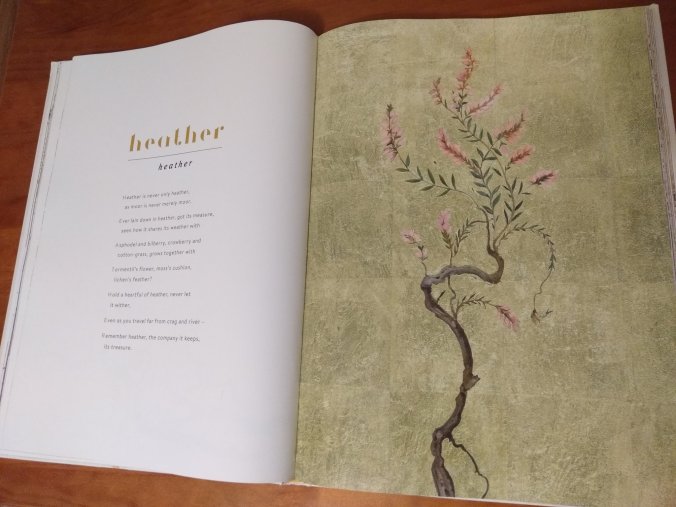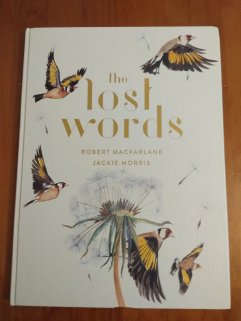The book entitled The Lost Words is a collaborative work highlighting the illustrations of artist and author Jackie Morris and the words of writer Robert Macfarlane, both based in the UK. The idea was conceived after a campaign involving artists, poets and writers, including Margaret Atwood, Andrew Motion and Morris and Macfarlane themselves, who were dismayed at the loss of certain words from the Oxford Junior Dictionary. Attempting to appear more relevant to today’s younger people, words often relating to the natural world, such as ‘buttercup’ or ‘lark’ were removed in favour of more contemporary terms such as ‘broadband’ and ‘blog’. The OJD, in doing so, highlighted a growing and concerning separation of children from nature and the outside world, indicative of a trend for a somewhat more isolated childhood spent mostly indoors and behind computer screens.

It was Morris’ idea, at first, to address the issue by creating a ‘wild dictionary’ incorporating many of the missing words. After a meeting with Macfarlane however, a collaboration of poetic incantations and accompanying poignant artwork was born. The resulting book is not intended solely for children, but, the authors suggest, may appeal to everyone. In turn, it is certainly a work that aroused a melancholic nostalgia for my own lucky childhood making willow bows and hazel arrows in the hazy clover filled meadows of my memories.
As the illustrations here both metaphorically and literally weave around words as heather roots in pebbles or otters diving playfully in bubbling eddies, Morris aids in not only the retrieval of lost words but in the creation of a beguiling and hopefully not lost natural world. The illustrator’s use of perspective whether depicting heron or dandelion, situates the viewer within the landscape, thus cleverly creating a connection with the image. While stimulating the senses in this way, the book raises conservation concerns without overt instruction therefore, subtlety allowing consideration of the kinship between the death of specific language with the loss of many species of flora and fauna. In turn, and fittingly, part of the profits from the book will be forwarded to a conservation charity who work with disadvantaged children. The Lost Words has also been part of a campaign to place it into many schools, so that the message reaches a new generation, perhaps before it is too late. It is a work based on hope however, to maintain both language and natural life, and the bridge that connects the two, which is indeed a pertinent point for all to contemplate.

It is obvious that this is a symbiotic work, both writer and artist gracefully enabling and enchantingly enhancing the other’s input. However, in the research for this article, it was apparent that much of the press coverage concentrated on Macfarlane as the main and sometimes only creative protagonist involved. In turn, a Google search indicated this shocking bias was widespread (certainly not the fault of Macfarlane himself who has always stated the equal and collaborative nature of the work).
Intrigued by this finding, I asked Jackie Morris if she had noted this lack of equity. The artist replied that this had been a common response and that a hierarchy of what she described as “word over image” was even apparent at an exhibition involving the artwork. The artist further added that in publicity events, Robert had been approached on occasions and asked to speak, while it seemed her own voice had been somewhat ignored and seemingly was “enough in images”. Articles had also focused on Macfarlane’s role in the project while illustrating the story with Morris´artwork and giving her only a minor credit. Morris declared a weary lack of surprise at the apparent sexism at work here, including an absence of support even from many fellow women in the business of promoting art…
“Why aren’t women more successful in the arts? Why are all the big names illustration men? I ____ wonder…..” the illustrator replied.
While certainly highlighting a familiar gendered bias, this lack of recognition also relates to a campaign Morris herself has supported. The Pictures Mean Business was created to raise concerns specifically for illustrators, from a common absence of sufficient credit, status and publicity to copyright issues. Judging from many of the responses to this collaborative work, these concerns are clearly justified.

Such matters, however, should not detract from the book itself, a compelling visual and poetic feast of captivating imagery and winsome wordsmithing which delightfully and provocatively align a sense of the natural world with human well-being.
Fittingly, the last word on The Lost Words should go to the illustrator herself however…
“This book was crafted with author and illustrator working closely together with the wild and wild things, to try to give a voice to the wild and to give a focus onto the nearby wild that we often take for granted. Image and word hand in hand…..The idea and the shape of the book grew from two creative minds working together with the support of one of the best publishing teams in Britain today….
“I love how the book is finding its natural habitat; libraries, homes, bookshops, and the hearts of families, uniting reading across generations…”

‘The Lost Words’ by Jackie Morris and Robert Macfarlane is published by Hamish Hamilton, and is currently the subject of an exhibition at The Foundling Museum, London, until 06 May 2018.